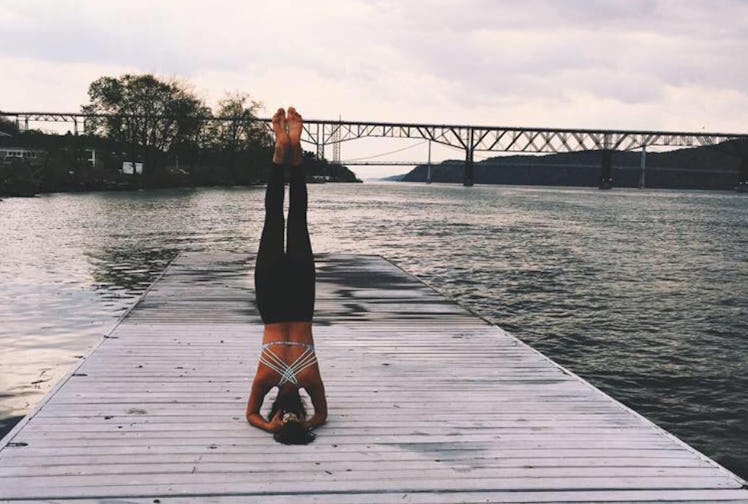
Yoga Inversions Are Hard AF, But These 5 Beginner Poses Will Help You Flip Upside Down
When you begin to experience the physical and mental growth that a consistent yoga practice brings, you might start craving those sacred moments between you and your mat each and every day. And if you've been practicing for a little while now, maybe you're itching to dabble in the waters of more advanced asanas, such as headstands, handstands, and, well, all things upside down! It's important to take it slow, and respect your body's signals when you start advancing your practice, which is why including yoga inversions for beginners into your flows will help develop the strength and confidence required to get upside down.
As a yoga teacher, I can tell you that inverting requires tons of core activation, shoulder strength, mental focus, deep breathing, and practice. It's easy to get frustrated when your teacher instructs a headstand in class, and you can't just do it right there on the spot, but remember, this stuff requires a bit of patience and a lot of practice, so don't rush the process, friend.
Plus, you might even be getting in your own head and psyching yourself out with the fear of the unknown — i.e. going upside down. But, if you practice these five beginner inversions on the reg, you'll be on your way to nailing your inversions in no time.
01Downward Facing Dog (Adho Mukha Svanasana)
Yes, my little yogis, your beloved downward dog is, indeed, considered an inversion — rejoice!
Some yogi beginners might underestimate their own strength, simply because they're not able to do headstands or handstands just yet in their practice. But you're actually inverting every time you strike a good ol' downward facing dog (because your head is below your heart), so quit selling yourself short, girl.
Whenever you're in adho mukha svanasana, make sure your fingers are spread really wide, so you're not dumping too much pressure on your wrists. Engage your shoulders, and draw your belly button toward your spine to activate your core. This is all great practice for being able to, one day, do a full-on handstand.
02Dolphin Pose (Ardha Pincha Mayurasana)
If a forearm balance is the inversion you're working toward, dolphin pose should definitely be a go-to pose in your yoga flow. Adding a daily dose of dolphin pose into your practice will mentally and physically prepare you for the full reversal that comes with a forearm stand, because you're, more or less, already halfway there in this asana.
Ardha pincha mayurasana majorly strengthens your shoulders and your core, and doing a couple of reps of walking inward and outward into this "V" shape will give your entire body a killer, yogi-style workout.
03Shoulder Stand (Salamba Sarvangasana)
If you feel like you're constantly on the brink of nailing your inversions, but at the last second, you psych yourself out and allow fear to get in the way, a shoulder stand might be an awesome building block to get used to the feeling of your legs being above your head.
Keep in mind, though, just because this pose is accessible for most beginners, that doesn't mean it's easy. While you're in your shoulder stand, you'll need to engage your legs, arms, and core the entire time, so that your spine isn't carrying all of your weight. Because of this, salamba sarvangasana will strengthen your muscles from head to toe, and become a great bridge toward more advanced inversions.
04Tripod "Egg" Pose
Flipping upside down into a tripod headstand is quite the tricky task, so why not start out with your knees resting on the backs of your forearms to help you get used to the new posture?
Tripod "egg" is the halfway point to a full tripod, because your arms are basically making a shelf for your legs to rest on, and you can really get acquainted with the feeling of being upside down.
When you're working on your egg-like shape, make sure to focus on your breath, keeping it balanced, equal, and expansive the entire time. It can be easy to forget about deep breathing during the exhilaration that comes with inversions, but it's incredibly important to continue implementing your ujjayi pranayama.
05Wall T-Stand
If you're craving a solid handstand practice, but you want to build the strength to kick up to the wall, T-stands are the perfect inverted exercise for you.
Make sure your hands are directly underneath your shoulders when you're practicing wall T-stands, and keep those fingers spread out nice and wide, just like in your downward facing dog.
Activate your core by pulling in your belly, and target your leg muscles by squeezing your glutes. Hold this pose for about five breaths. You can work your way up to holding it for longer periods of time, when you're more confident and stable in your T-stand.
Once you master these moves, you'll be standing on your hands with ease before you know it.